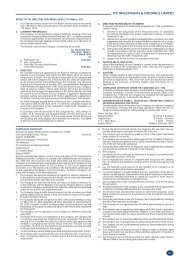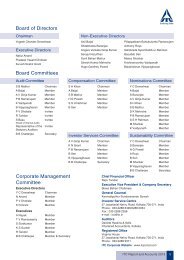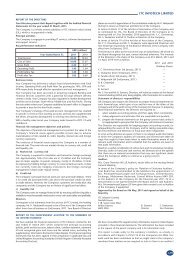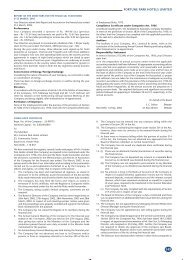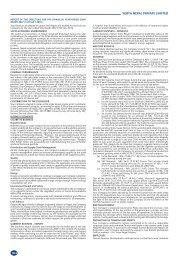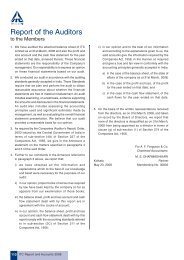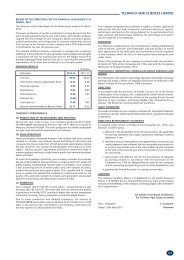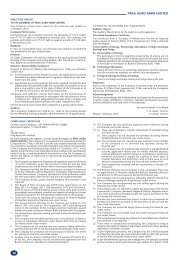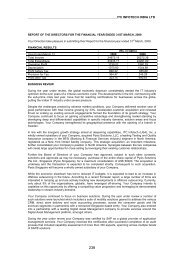SUBSIDIARY COMPANIES - ITC Ltd
SUBSIDIARY COMPANIES - ITC Ltd
SUBSIDIARY COMPANIES - ITC Ltd
Create successful ePaper yourself
Turn your PDF publications into a flip-book with our unique Google optimized e-Paper software.
TECHNICO ASIA HOLDINGS PTY LIMITED<br />
CASH FLOW STATEMENT FOR THE YEAR ENDED 31 MARCH, 2012<br />
2012 2011<br />
Notes $ ` $ `<br />
Cash flow from operating activities<br />
Net cash flows (used in)/from operating activities — — — —<br />
Cash flow from financing activities<br />
Net cash flows (used in)/from financing activities — — — —<br />
Net increase/(decrease) in cash held — — — —<br />
Add Opening Cash Brought Forward — — — —<br />
Cash and cash equivalents at end of period — — — —<br />
NOTES TO AND FORMING PART OF THE FINANCIAL STATEMENTS<br />
AS AT 31 MARCH, 2012<br />
Note 1: Statement of significant accounting policies<br />
(a) Basis of preparation and going concern<br />
The financial report is a special purpose financial report prepared for<br />
distribution to members of the company to fulfil the directors’ financial<br />
reporting requirements under Chapter 2M of the Corporations Act 2001.<br />
The accounting policies used in the preparation of this report, as<br />
described below, are in the opinion of the directors, appropriate to<br />
meet the needs of members.<br />
The financial report has been prepared on a historical cost basis and<br />
is presented in Australian dollars. The supplementary information in<br />
INR (Indian Rupees), which is unaudited, have been arrived at by<br />
applying the year end inter-bank exchange rate of 1 AUD = INR 52.9100<br />
for the current year balance sheet (2011: INR 46.1075) and the average<br />
rate of 1 AUD = INR 49.5088 for the current year income statement<br />
(2011: INR 43.6350) and have been included in the financial report<br />
as required by the Indian holding company of the parent entity.<br />
The directors have determined that the company is not a “reporting<br />
entity”. Consequently the requirements of Accounting Standards issued<br />
by the AASB and other professional reporting requirements do not<br />
have mandatory applicability to Technico Asia Holdings Pty Limited in<br />
relation to the year ended 31 March, 2012. However, the directors<br />
have determined that in order for the financial report to give a true<br />
and fair view of the company’s results of operations and state of affairs,<br />
the requirements of Accounting Standards and other professional<br />
reporting requirements in Australia relating to the measurement and<br />
recognition of assets, liabilities, revenues, expenses and equity should<br />
be complied with.<br />
Accordingly, the directors have prepared the financial report in<br />
accordance with the following Accounting Standards:<br />
AASB 101: Presentation of Financial Statements<br />
AASB 107: Cash Flow Statements<br />
AASB 108: Accounting Policies, Changes in Accounting Estimates<br />
and Errors<br />
AASB 1048: Interpretation and Application of Standards<br />
(b) Significant accounting judgements, estimates and assumptions<br />
The carrying amounts of certain assets and liabilities are often determined<br />
based on estimates and assumptions of future events. The key estimates<br />
and assumptions that have a significant risk of causing a material<br />
adjustment to the carrying amounts of certain assets and liabilities<br />
within the next annual reporting period are:<br />
Investment in subsidiaries<br />
The carrying value of the investment in subsidiaries is assessed at each<br />
reporting date as to whether there is an indication that the asset may<br />
be impaired. The assessment includes estimates and assumptions of<br />
future events including anticipated rates of growth, gross margins,<br />
together with the application of a discount rate. These assumptions<br />
correspond with the best estimates of management at reporting date.<br />
(c) Receivables<br />
Trade/other receivables are recognised and carried at the original<br />
amount less any provision for doubtful debts. A provision is recognised<br />
when collection of the full amount is no longer probable. Bad debts<br />
are written off as incurred.<br />
(d) Other financial assets<br />
Investments in controlled entities are recorded at cost less impairment<br />
of the investment value.<br />
(e) Impairment of assets<br />
The company assesses at each reporting date whether there is an<br />
indication that an asset may be impaired. If any such indication exists,<br />
or when annual impairment testing for an asset is required, the company<br />
makes an estimate of the asset’s recoverable amount. An asset’s<br />
recoverable amount is the higher of its fair value less costs to sell and<br />
its value in use and is determined for an individual asset, unless the<br />
asset does not generate cash inflows that are largely independent of<br />
those from other assets or groups of assets and the asset’s value in use<br />
cannot be estimated to be close to its fair value. In such cases the asset<br />
is tested for impairment as part of the cash-generating unit to which<br />
it belongs. When the carrying amount of an asset or cash-generating<br />
unit exceeds its recoverable amount, the asset or cash-generating unit<br />
is considered impaired and is written down to its recoverable amount.<br />
In assessing value in use, the estimated future cash flows are discounted<br />
to their present value using a pre-tax discount rate that reflects current<br />
market assessments of the time value of money and the risks specific<br />
to the asset. Impairment losses relating to continuing operations are<br />
recognised in those expense categories consistent with the function<br />
of the impaired asset.<br />
(f) Payables<br />
Trade payables and other payables are carried at amortised costs and<br />
represent liabilities for goods and services provided to the company<br />
prior to the end of the financial year that are unpaid and arise when<br />
the company becomes obliged to make future payments in respect of<br />
the purchase of these goods and services.<br />
(g) Contributed equity<br />
Ordinary shares are classified as equity. Incremental costs directly<br />
attributable to the issue of new shares or options are shown in equity<br />
as a deduction, net of tax, from the proceeds.<br />
85




